geändert 09.04.2024
My car
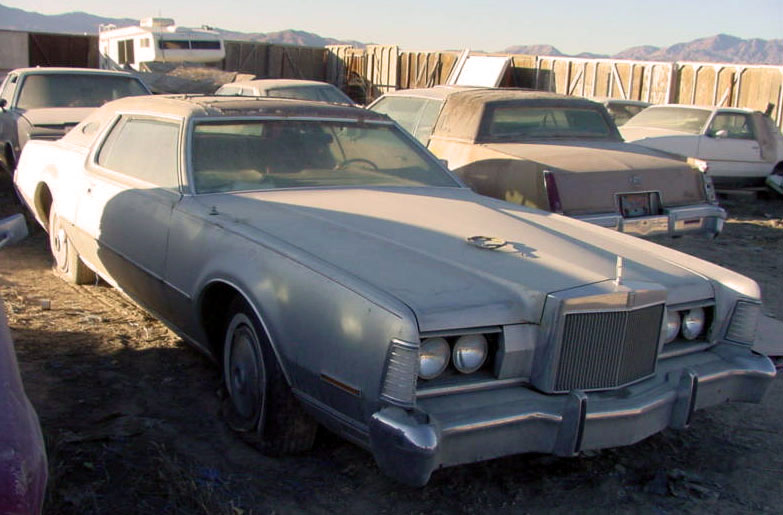
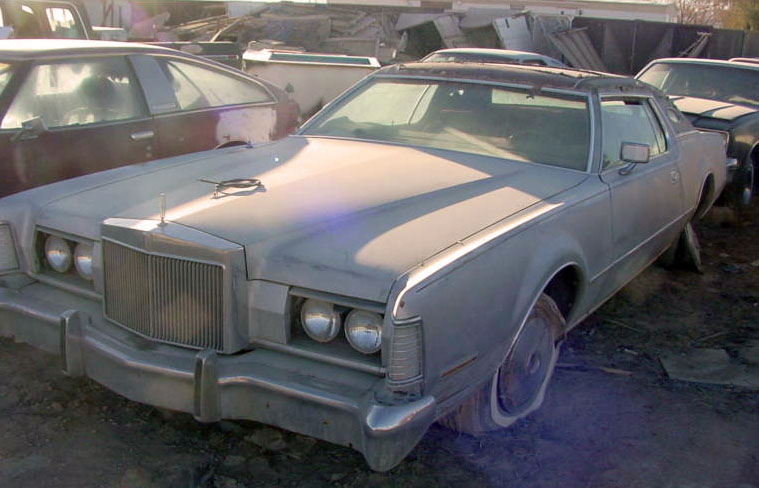
Other examples
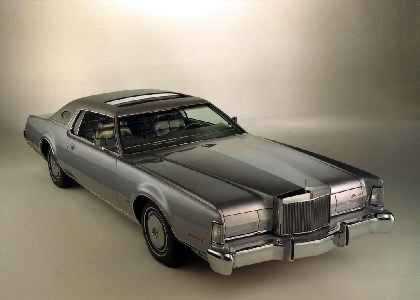
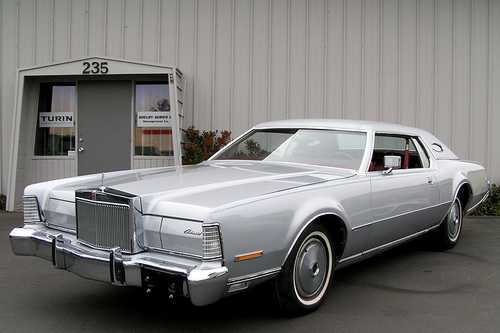

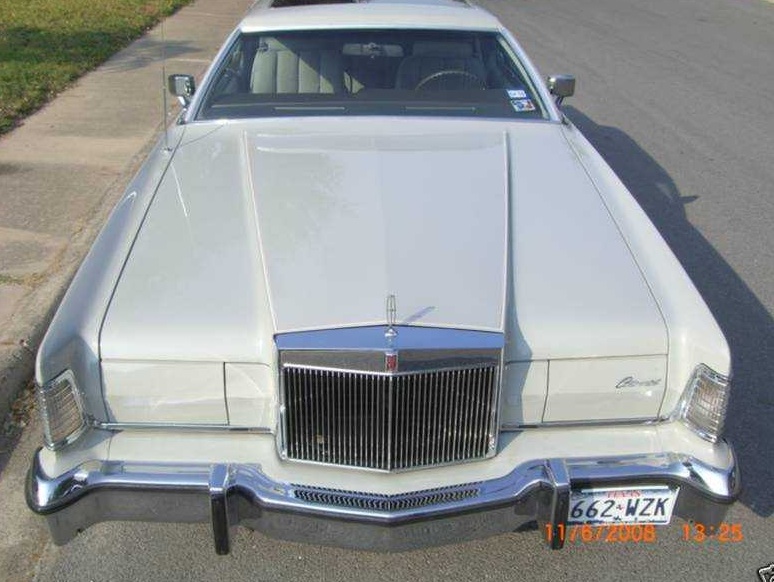


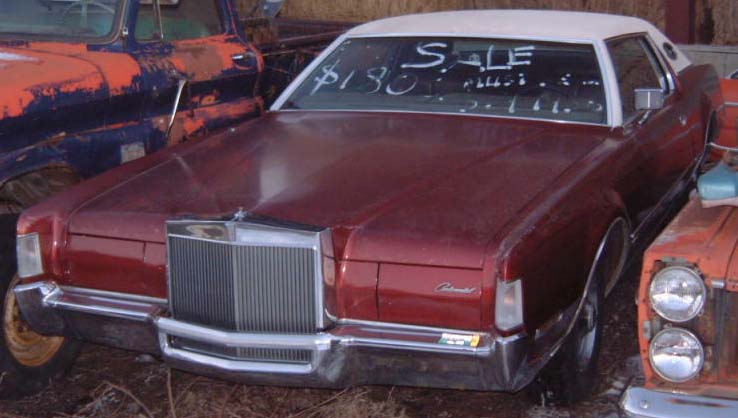
Lincoln Continental Mark IV ![]()
Lincoln Continental Mark IV Coupé, BJ 1973
http://automotivemileposts.com/mark41973selections.shtml
1973: 69437 Stück gebaut, Neupreis damals US$ 8984,-. Silver Luxury Edition extra ¨¨US$ 400,-.
![]()
The 1973 Continental Mark IV.
Quite simply, the most beautiful car in America.
The 1973 Continental Mark IV was, quite simply, the most beautiful automobile in America. And if people loved last year's version, they adored this year's as well. For 1972, the new Mark IV set sales records, and it would do so again with 69,437 cars built for the 1973 model year.
Cadillac's Eldorado, by comparison, built 51,451 cars for the model year, which places the Mark IV ahead by 17,986 units, a considerable difference.
For 1973, Mark IV buyers could choose from 24 different shades of paint, 9 of them optional Moondust Metallics which cost extra. 8 different colors were available for the paint stripe, and 9 different Calvary Twill vinyl colors were available as well. Inside, 7 colors of Westminster Cloth and vinyl were standard, with 13 different colors offered for the optional Genuine Leather seating surfaces with vinyl side panels. Additionally, a Cranberry Victoria Velour Cloth was part of the Silver Luxury Group, and was not available separately.
Changes for 1973 were few. On the exterior, a new 5 mph front bumper system was mandated, and this required a significant change from the gorgeous front end treatment used the previous year. But Lincoln pulled it off, and left the majority of the original design's integrity intact.
A new optional rear bumper guard was part of the Appearance Protection Group, and was nicely integrated into the overall rear design.
A Remote Control Right Hand Mirror was made available as an option for the first time, which was a welcome and popular option since it could be adjusted from the driver's seat using a control toggle on the instrument panel, just to the left of the radio. The previously mentioned Silver Luxury Group was a new trim package for 1973, which was fairly popular and would be expanded in the years to come with different colors and combinations of trim and options, to give each one a distinct appearance. The Silver Luxury Group combined Silver Moondust Metallic paint with a Silver Levant Grain Vinyl Roof, Cranberry Victoria Velour Cloth upholstery, and matching Cranberry paint stripes. Silver or Dark Red Leather was also offered, if the velour was not your thing. For $400, it provided a higher level of distinction than other Marks.
The opera window, introduced the previous year, was made standard for 1973 and was a significant factor in the Mark IV's popularity at the time.
A new AM/FM/Multiplex Stereo Radio with Tape System gave occupants true stereo sound through four speakers which could be balanced either front to rear or from side to side for the best overall sound. It was a popular option, and allowed Lincoln to more closely match its competitor's offerings in the sound department, although Cadillac still offered a signal seeking AM/FM stereo radio, which the Mark wouldn't have for a few more years.
The optional Electric Power Door Locks were revised for 1973, which resulted in moving the control switches from the plunger knob to the front door arm rests. This location was more convenient for most, and was combined with the Electric Remote Trunk Lid Release in the "Lock Convenience Group" option, where both could be had for just $93.36.
A new feature offered for the first time was the Moonroof, which was basically a power sunroof with a Silver-tinted glass panel that allowed occupants to see out when it was shut. A shade could be closed manually to completely block out all light if desired, but would open automatically when the glass panel was opened.
At $777.40, it was the most expensive option offered for 1973, and garnered a $166.12 premium over an above the cost of the power sunroof, which was the second most expensive option that year, priced at $611.28.
Lincoln's advertising took on long time rival Cadillac with ads that stated, "The Continentals beat the other make of luxury car again." When comparing ride and handling, Lincoln's testing indicated that more people preferred Lincoln over the "other make."
Lincoln described its ride as offering deep, deep quiet.
One automotive writer noted that the Mark IV was so quiet, he could hear himself breathe.
At this time, even some long time Cadillac owners had expressed a concern that quality had slipped a bit, and that some of the interior appointments were not what they had been in the past. Now, this was true of most American cars of the time, but it's apparent that Lincoln was more adept at adding fake wood touches than Cadillac was at the time.
As for Lincoln's statement that their cars were quiet, anyone who rode in one new can attest to the fact that you do not hear outside noises, even at highway speeds. You feel totally isolated from the world outside, which was exactly what most luxury car buyers wanted at the time. As for the appearance, that speaks for itself.
Mark IV
In 1972, the Lincoln Continental Mark IV was introduced and would stay in production until 1976.
It was similar to its predecessor but grew in both length and width. It still shared a platform with the Thunderbird and in many respects, were similar. There were few differences of the Mark III and the Mark IV. The Mark IV was slightly rounder, the wheel openings were a little different, and optional opera windows were installed. The grille was longer and a new bumper adorned the front of the vehicle. The popular vinyl roof was now standard. In 1973, a new federally mandated 5 mph bumper was installed.
Under the hood was a 460 cubic-inch Ford 385 Series V8 capable of producing just over 210 SAE horsepower.
Power was sent to the wheels courtesy of a C6 3-speed automatic transmission.
Sales were strong for the Mark IV with the lowest production year being in 1975 with 47,145 units sold. 1973 was the strongest year for sales with 69,437. With total sales amounting to 278,559 for the five years of production, the average total sales per year was 55719. 1976 had strong sales partly because of the newly introduced Designer Series. These were special edition Mark IV that were given color, trim and interior choices by famous designers. The designers' signature was placed on the opera windows and a 22 karat gold plated plaque could be found on the instrument panel. The gold plaque could be engraved with the original owners' name.
There were four designer editions offered:
Lincoln Continental Mark IV (1971-1976)
Continental Mark IV
Für das Modelljahr 1972 lancierte Lincoln den Continental Mark IV, um im wachsenden Segment der Personal Luxury Cars an den Erfolg des Mark III anzuknüpfen. Das konservative Design des Mark III wurde durch die Betonung der „long hood - short deck“ Proportionen des Mark IV noch extremer und eleganter. Nach dem Motto: „bigger, better, faster - more!“ wurden die Elemente des Mark III mit hohem, schmalem Kühlergrill, abgedeckten Scheinwerfern und Pseudo-Reserveradbuckel im Kofferraumdeckel auch beim Mark IV aufgenommen und weiterentwickelt.
Der Mark IV teilte sich die Plattform mit dem gleichzeitigen Ford Thunderbird und war erheblich länger und breiter als alle Vorgängermodelle.
Nahezu alle Extras wurden beim Mark IV nun mit elektrischen oder pneumatischen Antrieben versehen und damit wurde das Fahrzeug noch schwerer als die Continental-Limousine (Viertürer) des gleichen Baujahres.
Wegen des hohen Gewichtes von über 2,3 Tonnen wurde statt einer Unibody-Konstruktion, wie beim frühen Mark III, eine Body-on-Chassis-Konstruktion gewählt. Diese Body-on-Chassis-Konstruktion ist beim Mark IV mit der Leiterrahmen-Konstruktion von LKWs und Geländewagen eng verwandt.
Die Sitzhöhe des Fahrers und der Passagiere wurde aufgrund ästhetischer Überlegungen gegenüber der Straße nicht verändert, jedoch wurde durch die höhere Unterkonstruktion der Boden in den Innenraum hineingehoben und dadurch verringerte sich auch der Abstand zwischen Innenboden und Sitzfläche. Als Resultat fanden Fahrer und Passagiere sich im Mark IV in einer mehr liegenden Position im absurderweise verkleinerten Innenraum des Mark IV.
Dieser Effekt setzt sich auch bis in den Kofferraum fort. Eines der bis heute größten Coupes der Automobilgeschichte hat somit nur einen vergleichsweise kleinen Kofferraum. Das zentral liegende Reserverad lässt hier keinen Platz für Koffer mit normaler Größe. Lediglich kleinere Sporttaschen können im Kofferraum des Mark IV Platz finden.
Zur Serienausstattung gehörte bereits 1972 auch wieder das
Die berühmten „Opera-Windows“ waren im Jahr 1972 noch eine Option. Aufgrund der hohen Beliebtheit dieser beleuchteten runden Fenster mit dem Lincoln-Stern in der C-Säule des Mark IV gehörten diese ab dem Modelljahr 1973 ebenfalls zur Serienausstattung. Heutzutage sind nur noch wenige 1972er Lincoln Continentals Mark IV ohne Opernfenster erhalten.
Im Jahr 1972 war auch eine spezielle vordere Stoßstange erhältlich, die durch einen tiefen Ausschnitt mehr Sichtbarkeit für den Rolls-Royce-Grill gewährte. Diese Dropped Bumper Option wurde ab dem Modelljahr 1973 durch Einführung der gesetzlich vorgeschriebenen Sicherheitsstoßstangen (Federal Bumper) nicht mehr angeboten.
Alle Mark IV hatten ein vollflächiges Vinyldach, das später im Mark V nur noch als verkürztes Landau-Roof angeboten wurde.
Als typisch amerikanisches Coupe wurde der Mark IV ohne B-Säule konstruiert. Die Seitenfenster teilen sich damit in ein langes Teil, das vollständig in der rahmenlosen Tür versenkt werden kann und ein kurzes Teil, das sich immerhin elektrisch, jedoch aber nur wenige Zentimeter bewegen lässt, obwohl das Volumen der rückwärtigen Fahrzeugwangen einer vollständigen Versenkung nicht im Wege gestanden hätte. Die Konstruktion eines entsprechenden Senk- und Kipp-Mechanismus erschien den Entscheidern in Lansing und Dearborn wohl als zu aufwendig, zu teuer oder zu riskant.
Für den Antrieb sorgte der bereits im Mark III eingeführte Ford 7,5 l-V8 (460 cui) aus der 385er Baureihe, einer der größten im Ford-Konzern jemals hergestellten PKW-Motoren. Dieser Motor galt in den Jahren 1976 bis 79 als der größte in einem PKW verbaute Serienmotor weltweit. Ein Zeugnis davon, das die Lincoln-Käuferschicht es sich noch lange leisten konnte, die Folgen der ersten Ölkrise von 1973 zu ignorieren.
Die knapp 210 DIN-PS (360 PS SAE) dieses Motors wurden durch einen relativ kleinen Vergaser und eine entsprechend „zu klein“ dimensionierte Ansaugbrücke erreicht. Bei zurückhaltender Fahrweise war beim Mark IV ein Durchschnittsverbrauch von ca. 18L im Drittelmix machbar.
Der 460er Ford-Motor ist von der Konstruktion, Getriebe und vom Antriebsstrang her für ein Drehmoment von fast 800 Nm ausgelegt und kann ohne große Eingriffe eine Leistung von über 450 DIN-PS in einem breiten Drehzahlbereich entfalten.
Die serienmäßige "Drosselung" des Motors war ein taktischer Schachzug des Lincoln-Marketings, um bei den Versicherungsunternehmen keine umsatzbeinträchtigenden Ängste zu wecken.
Noch heute sind diese Motoren noch bei Monstertruck- und Tractorpulling- Enthusiasten wegen Ihrer enormen Leistung sehr beliebt.
Ab dem Baujahr 1974 wurde im Mark IV die von Lincoln erfundene und entwickelte heizbare Heckscheibe (Defog Window) in die Serienausstattung übernommen. Ironische Zeitzeugen werten dies als Beweis, das die Firma Lincoln zu dieser Zeit wohl auch deutlich größere Probleme mit Kondensierungseffekten als der Wettbewerb gehabt hätte.
Mit dem Modelljahr 1976 führte Lincoln für den Mark IV Sondermodelle ein, deren optische Gestaltung angeblich der Hand berühmter Modedesigner entstammte und die deshalb Designer Series genannt wurden; eine Marketing-Idee, an der Lincoln lange Jahre festhielt. 1976 gab es die Bill-Blass-Edition (dunkelblauer Lack, beigefarbenes Vinyldach, blau/beiges Interieur); die Cartier-Edition (grauer Lack, graues Vinyldach, graues Interieur); die Givenchy-Edition (aquamarinblauer Lack, weißes Vinyldach, aquamarinblaues Interieur) und die Pucci-Edition (dunkelroter Lack, silbergraues Vinyldach, Interieur in Dunkelrot. Die Designer-Series Fahrzeuge haben alle das Signet des Designers im Opera-Window und eine mit den Signet versehene, vergoldete Plakette auf dem Armaturenbrett, welche auch noch Platz für eine Gravur des Namens des Besitzers bot.
Der Mark IV wurde in fünf Jahren über 278.000 Mal gebaut.
1973 Standard Equipment 460 CID 4V V-8 Engine Select-Shift Automatic Transmission WSW Steel-Belted Radial Ply Tires Power Front Disc Brakes Sure-Track Brake System Automatic Parking Brake Release Power Steering Power Side Windows Twin Comfort Lounge Seats 6-Way Power Seats, both sides Automatic Air Conditioning Concealed Headlamps Cornering Lights AM Pushbutton Radio with Dual Front and Rear Speakers and Power Antenna Remote Control Driver's Side Rearview Mirror Long-Shear Cut-Pile Carpet Deluxe Color-Keyed Seat and Shoulder Belts Black Cut-Pile Carpet in Luggage Compartment with Spare Tire Cover Opera Window New for '73 Electric Windshield Wipers Windshield Washer 3-Spoke Rim-Blow Steering Wheel Folding Center Armrests—Front and Rear Front Bumper Guards with Rubber Inserts New for '73 Inside Hood Latch Release Stand-up Continental Star Ornament Reversible Keys Keyless Door Locking Cartier Chronometer (shown at right) Automatic Seat Back Release Visor Vanity Mirror Door Assist Straps Curb Moldings Triple-Note Horns Trip Odometer Spare Tire Lock Full Wheel Covers
Optional Equipment Appearance Protection Group ($46.10) - Door Edge Guards - Front and Rear Floor Mats with Carpet Inserts - Horizontal Rear Bumper Protection Strip Automatic Headlamp Dimmer ($49.88) Moondust Metallic Paint ($127.88) Interval Windshield Wipers ($25.57) Remote Control Right Hand Mirror ($26.67) New option for '73 Electric Rear Window Defroster ($83.13) Power Sunroof ($611.28) Power Moonroof ($777.40) (Silver Luxury Group only) New option for '73 Lock Convenience Group ($93.36) - Electric Power Door Locks - Electric Remote Trunk Lid Release AM/FM Multiplex Radio ($141.96) AM/FM Multiplex Radio with Stereo Tape System ($311) New option for '73 Automatic Speed Control ($92.08) Tilt Steering Wheel ($70.35) Traction-Lok Rear Axle ($55) Silver Luxury Group ($400) Leather Seating Surfaces ($179.04) Reclining Passenger Seat ($61.39) Bodyside Vinyl Insert Molding ($33.25)
The Power Sunroof was not popularly ordered, making it a rare option that is highly sought after today. The opening measures about 36" wide by 20" deep. Front head room is reduced about 1".
SILVER LUXURY GROUP AT A GLANCE:
 Years Available: 1973-1975
Years Available: 1973-1975
Body Color Code: 1D - Silver Moondust Metallic
Paint Stripe Code: D - Cranberry
P - Silver Metallic
Vinyl Roof Code: (researching code) - Silver Levant Grain Vinyl Roof
Interior Trim Code: AH - Cranberry Victoria Velour Cloth
(researching code) - Silver Leather with
Vinyl
Price: $400.00
Show cars were always intended to attract new potential buyers to dealer
showrooms. Although most weren't available for sale to the public, they
did have the effect of improving sales for models that were for sale. Over
the years, American automobile manufacturers went to great lengths and
expense to create custom automobiles that would amaze and delight the public,
with the hope it would encourage those folks to visit their local dealers
to see what was available, and perhaps fall in love and purchase a new
car. This idea worked well—so well in fact that General Motors' Motorama
(also known as Autorama from 1949-1952) became a huge success. So successful,
in fact, that it actually took to the road in 1953 and became a touring
car show, which resulted in the name change to Motorama. From 1953 until
1961, GM's Motorama was a phenomenon that drew huge crowds of people where
ever it stopped. Concept cars, prototypes, and one-off custom designs were
exhibited to the public for their approval (or disapproval).
Apparently the public desired something different—and was willing
to pay for it—which meant that car makers needed to find a way to
make that happen. Ford Motor Company was among the first to get special
models into dealer showrooms. In 1954, Ford introduced the Ford Crestline
Skyliner and the Mercury Monterrey Sun Valley, both two door hardtop models
with a transparent, tinted plastic roof over the front seat. The Mercury
was built for only two years, being renamed the Mercury Montclair Sun Valley
for 1955 before being discontinued. Ford's transparent roof car was also
renamed for 1955, and carried the name Ford Crown Victoria Skyliner through
1956, after which the transparent roof feature disappeared and the Skyliner
moniker was used for Ford's new retractable hardtop. A total of 27,294
of these transparent roof cars were made during the production run, and
its demise is generally credited as being due to the uncomfortably hot
interior temperatures, a problem in all but the coolest weather. A snap-in
sun shade was an available option, as was air conditioning, but these were
new concepts at the time that most people simply did not choose to order.
The problem with these unique models is that they were expensive to design,
tool, and build. But if a way to adorn a current model could be found,
that would be inexpensive to produce, it would be more fiscally attractive
to the car makers. Lee Iacocca is generally credited with this idea, as
he was able to increase sales of the 1962 Ford Thunderbird by creating
two new models from the two models offered in 1961. The Hardtop model became
the Landau model with the addition of a leather-grained vinyl roof cover
and simulated S-bars on the roof sides, and the Convertible became the
Sports Roadster with the addition of three unique emblems, an instrument
panel-mounted assist bar, a fiberglass tonneau cover, and sporty Kelsey-Hayes
wire wheels. Overnight, the number of available Thunderbird models doubled
to four.
This concept was carried even further the following year, with the mid-year
announcement of the 1963 Thunderbird Limited Edition Landau. Available only in a Wimbledon White finish with Rose Beige Vinyl Roof
and White Leather upholstery, this model featured simulated Rosewood paneling
on the inside, and had carpeting on the bottom of the door panels. A numbered,
engraved dash plaque announced this was something special. Other than that,
there was nothing unique about the car to set it apart from a standard
Landau model. It was basically a typical Thunderbird Landau, with special
colors and a few pieces of unique trim. A splashy party was held in Monaco,
which just happened to coincide with the annual Monaco Road Rally. Price
Rainier and Princess Grace were in attendance, and the first car of the
limited production of 2,000 was given to Prince Rainier as a gift from
Ford Motor Company. Even Vogue Magazine was in on the deal, snapping pictures
of high fashion models posed with new Thunderbirds to appear in the pages
of its magazine. To cap off the event, a television special, Tour of Monaco was aired on February 17, 1963. Ford also prepared special brochures for
the car, and mailed them from Monaco to prospective customers in the U.S.
Of course, every Limited Edition Landau was sold, and this served as proof
that more interest in a car line and additional sales could be obtained
just by adding a little bit of special trim, or by using unique color combinations
and declaring this use a special, limited edition model.
A 1965 Thunderbird Special Landau followed in 1965, with production set at just 4,500 cars. It too differed
from standard Landaus only by the use of a few pieces of unique trim and
a color combination not otherwise available. Iacocca had definitely found
a way to increase dealer showroom traffic and sales, create an air of exclusivity,
and did so at minimal cost and maximum profit! Ford would continue to market
special edition Thunderbirds during the seventies and beyond, beginning
with the 1974 Thunderbird Burgundy Luxury Group and White and Gold Luxury
Group.
Lincoln's first entry into this concept was the 1971 Lincoln Continental
Golden Anniversary Town Car. Built to commemorate the 50th Anniversary
of Lincoln, the four door cars were painted in Anniversary Gold Moondust
Metallic, a special gold color available only on this model, with "Town
Car" block lettering on the front fenders and rear deck lid. Unique
interior trim was done in Black with a specific sew style on the seats,
and was highlighted by Brazilian Rosewood appliques with polished chromium.
22 carat gold ignition and door keys and a Limited Edition plaque on the
instrument panel set it apart from all other Lincolns in 1971.
 In 1973, Lincoln followed this with the introduction of the Silver Luxury Group for the Continental Mark IV. Painted in a special Silver Moondust Metallic
(paint code 1D) finish, it featured a Silver Levant Grain Vinyl Roof and
Cranberry Victoria Velour Cloth (code AH) trim or Dark Red Leather (trim code DD) for the seating surfaces.
A high luster Silver Leather interior (shown at right - researching code)
was also available. Color-keyed body side paint stripes in Silver Metallic
(code P) or Cranberry (code D) graced the exterior, and Cranberry or Silver
luggage compartment trim and spare tire cover completed the package. Viola!
An instant limited edition model, which cost next to nothing to produce,
and garnered a $400 premium when ordered.
In 1973, Lincoln followed this with the introduction of the Silver Luxury Group for the Continental Mark IV. Painted in a special Silver Moondust Metallic
(paint code 1D) finish, it featured a Silver Levant Grain Vinyl Roof and
Cranberry Victoria Velour Cloth (code AH) trim or Dark Red Leather (trim code DD) for the seating surfaces.
A high luster Silver Leather interior (shown at right - researching code)
was also available. Color-keyed body side paint stripes in Silver Metallic
(code P) or Cranberry (code D) graced the exterior, and Cranberry or Silver
luggage compartment trim and spare tire cover completed the package. Viola!
An instant limited edition model, which cost next to nothing to produce,
and garnered a $400 premium when ordered.
 A new power glass Moonroof (shown at left) with Silver tint was available.
Lincoln said when it was open, you saw the Moon and it saw you, but when
it was closed, only you had the view.
A new power glass Moonroof (shown at left) with Silver tint was available.
Lincoln said when it was open, you saw the Moon and it saw you, but when
it was closed, only you had the view.
The snob appeal was intense. High brow advertising made certain everyone
knew that the silver Mark IV pulling up in their neighbor's driveway was
something special, and was such a popular option that additional Luxury
Group option packages would become available the very next year, and expand
greatly in the years to come.
Some 1973 Continental Mark IV Silver Luxury Group cars have been documented
as having paint stripes that do not coordinate with the interior trim.
Normally, a Cranberry stripe was provided with Silver interiors, and a
Silver paint stripe accompanied the Cranberry interiors, but Black body
side paint stripes have also been noted with both interior colors. We've
also noted Cranberry stripes with Cranberry interiors and Silver stripes
with Silver interiors, which makes the most sense to us. We aren't certain
if they were ordered in this manner, or if they were due to a factory error,
but there is no doubt they left the factory in this manner.
At any rate, the Luxury Group option was a brilliant idea that allowed
Lincoln's customers to have a bit more distinction in their transportation,
and would allow Lincoln to produce and market unique cars at minimal cost
to expand their market reach. For 1974, two Luxury Groups would be offered.
This would increase to five for 1975, and expand to nine for 1976—thirteen
if you include the Designer Edition cars.
After the success of Continental Mark III in the market, Lincoln decided to pursue the production of the Continental Mark, changing its name into Lincoln Continental Mark IV. In this generation, the achievement of the first Continental Mark model was made even astounding. And just as the first one, Lincoln Continental Mark IV also occupied the top level of the personal luxury car market. From the first year of its release in the market in 1972, it proved its capability to satisfy the customers. As what is expected of Continental Mark IV, it in return provided remarkable sales record. It can be seen in the stable number of production as against the pricing. Unlike its predecessor, Continental Mark IV lived for four years, half longer. This was all because of what's under Mark IV's hood and everything within its chassis.
The powertrain was a 7.5 liter Ford 385 series V8 engine, and is being mated by the C6 3-speed automatic transmission, powering 202 horses at 38000 rpm and torque of 356 pounds per feet at 2200 rpm, quite impressive for an early model.
It possessed almost every character of Mark III, the Rolls-Royce-style grille, long-hood short deck, covered headlamps, and fake spare tire on the rear deck. The difference is it's longer and wider with a slight rounded shape, instead of the sharp fender line, Mark made use of only a slight character of it, and was symmetrical from the fa'ade to rear. Continental Mark IV featured vinyl roof and opera window. In the production of Lincoln Continental Mark IV, the division introduced the Designer Series. It's the special edition that boasts opera windows as the designers signature, 22 karat gold plated plaque on the instrument panel. They are available in various colors, trims and interior choices which include Bill Blass edition, Cartier Edition, Givenchy Edition, and Pucci Edition. The first one came with dark blue accents both on the exterior and interior moldings. The next edition was in dove grey, Givenchy in aqua blue, and Pucci in red and silver design. Lincoln Continental Mark IV is the contemporary of Ford Thunderbird. They are the same platforms, actually considered as twins, both built in the same factory plant in Wixom, Michigan in North America. Like the Continental Mark III, Lincoln Continental Mark IV was replaced by the next generation upgraded Continental Mark V.